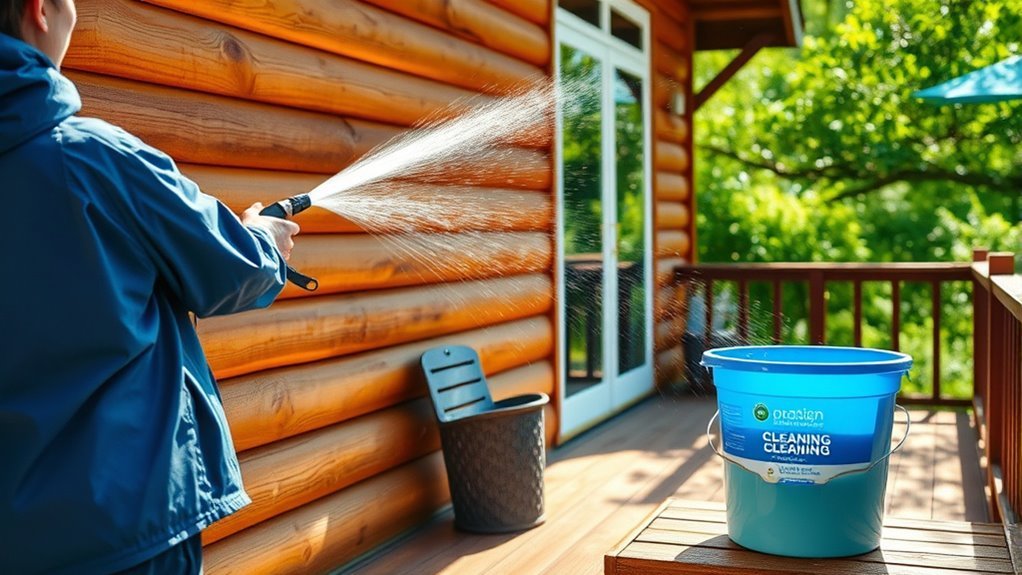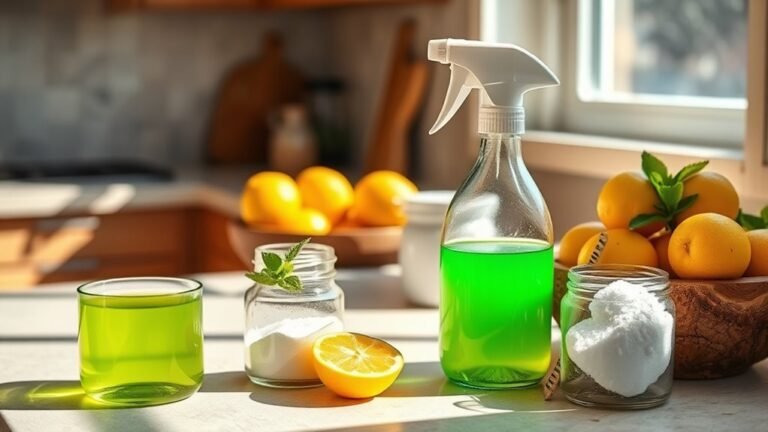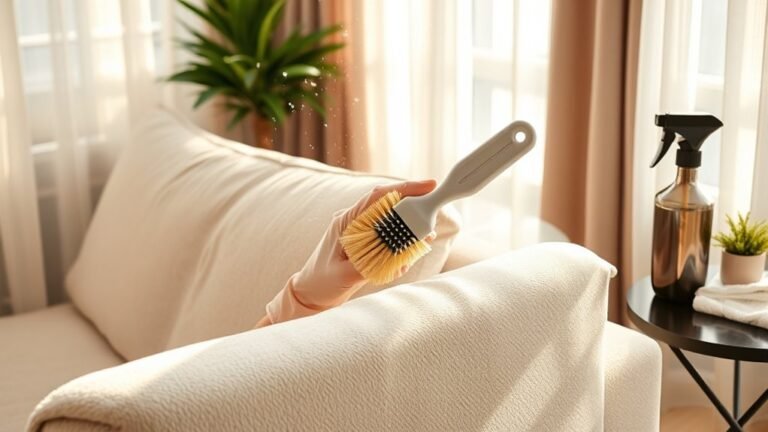How to Clean Cedar Siding
To clean cedar siding, gather your tools like a pressure washer, soft-bristle brush, and eco-friendly cleaning solution. Remove nearby furniture for easy access and rinse the surface to eliminate loose dirt. Start at the top and work your way down using even strokes. Don’t forget to inspect for any damage and rinse thoroughly after cleaning. For best results and protection, consider applying a finish. Keep going to uncover more tips and techniques for perfect cleaning!
Preparation For Cleaning
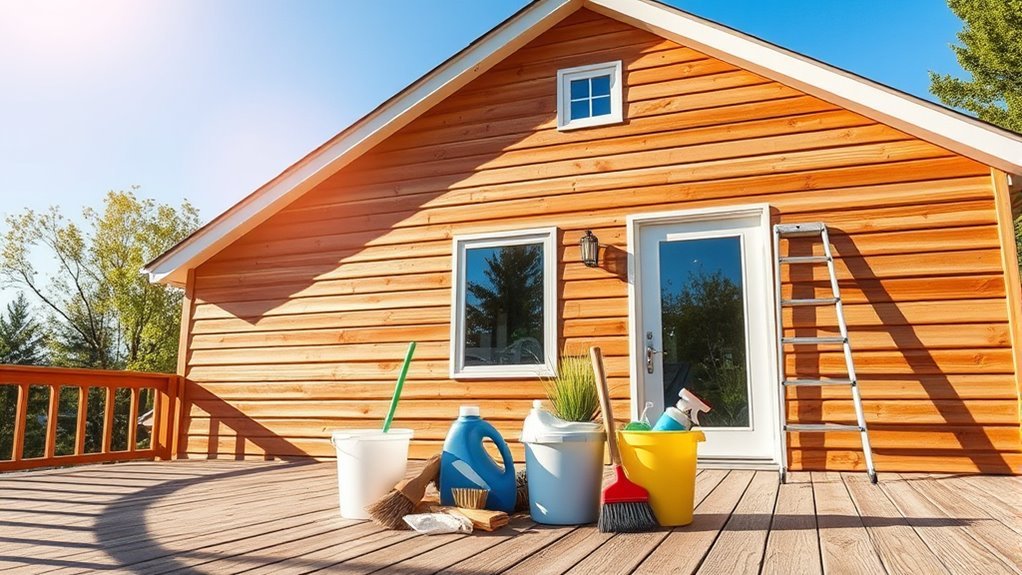
Before you start scrubbing away at your cedar siding, it’s important to gather the right tools and materials to secure an effective cleaning process. First, assess the surface condition; if there’s mold or mildew, you’ll need specific cleaning techniques to tackle those issues. Remove any furniture or objects near the siding to prevent damage and create a clear work area. Next, prepare the surface by rinsing it with water to eliminate loose dirt and debris. This step guarantees that your cleaning agents can penetrate effectively. If necessary, patch any damaged areas beforehand to avoid further deterioration during cleaning. With the right preparation, your cleaning efforts will yield a beautiful, revitalized cedar siding that enhances your home’s appeal.
Tools and Chemical Required
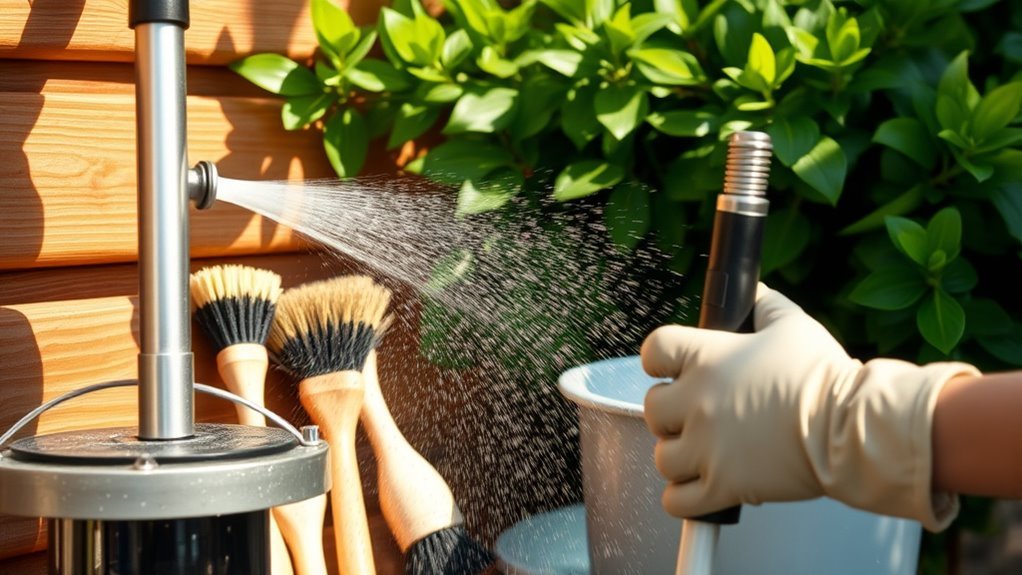
To effectively clean your cedar siding, you’ll need a few essential tools and chemicals that guarantee a thorough job. A pressure washer is key for removing dirt and grime quickly. You’ll also want a selection of cleaning solutions tailored for wood surfaces to protect the integrity of the cedar. Don’t forget to gather protective gear like gloves and goggles for safety. Using the right cleaning materials ensures the wood remains undamaged and looks its best.
Here’s a quick reference table for your cleaning essentials:
| Tool/Chemical | Purpose | Notes |
|---|---|---|
| Pressure Washer | Removes dirt and mildew | Use with caution on wood |
| Wood Cleaning Solution | Cleans without damage | Look for eco-friendly options |
| Protective Gear | Guarantees safety during cleaning | Always wear while working |
How to Clean:

Step 1: Gather Your Tools and Cleaning Solutions
- Collect the necessary tools: Before you begin, ensure you have a gentle pressure washer or a soft-bristle brush on hand.
- Choose your cleaning solution: Opt for a mild detergent or a specialized cedar siding cleaner. Make sure it’s suitable for wood surfaces.
Step 2: Choose Your Cleaning Method
- Gentle Pressure Washer: If using a pressure washer, set it to a low-pressure setting to avoid damaging the wood.
- Soft-Bristle Brush: If opting for a brush, ensure it’s soft to prevent scratching the surface of the cedar siding.
Step 3: Start Cleaning from the Top
- Begin at the highest point: Starting from the top of your siding allows dirt and debris to flow downward as you clean.
- Use even strokes: Whether using a pressure washer or a brush, apply even pressure to maintain consistency in cleaning.
Step 4: Work Your Way Down
- Move systematically: Gradually work from the top to the bottom, ensuring you cover every area thoroughly.
- Avoid streaking: Cleaning from top to bottom helps prevent streaks that can occur if you go in a different direction.
Step 5: Rinse Thoroughly
- Ensure no residue remains: After cleaning, rinse the siding thoroughly with clean water to remove any soap or cleaning solution.
- Check for missed spots: Look for any areas that may need additional cleaning or rinsing.
Step 6: Address Stubborn Stains
- Identify tough stains: If you encounter any stubborn stains that don’t come off, consider using a specialized cedar siding cleaner.
- Follow product instructions: Apply the cleaner according to the manufacturer’s directions for best results.
Step 7: Inspect for Damage
- Check for loose boards: During your cleaning session, take the time to inspect the siding for any loose boards or damage.
- Address any issues: If you find any problems, make a note to repair them to maintain the integrity of your siding.
Step 8: Apply a Protective Finish
- Enhance natural beauty: After cleaning, consider applying a protective finish to the cedar to preserve its natural beauty and increase longevity.
- Choose an appropriate product: Look for finishes specifically designed for cedar to ensure compatibility. Applying a protective sealant can also help prevent moisture damage and prolong the life of your siding.
Step 9: Regular Upkeep
- Schedule routine cleanings: To keep your cedar siding looking vibrant and inviting, establish a regular cleaning and maintenance schedule.
- Stay proactive: Regular upkeep will prevent buildup and extend the life of your siding, saving you time and effort in the long run.
Safety Consideration
While cleaning cedar siding can be a straightforward task, it’s crucial to prioritize safety throughout the process. Start by wearing protective gear, like gloves and goggles, to shield yourself from cleaning solutions and debris. If you’re using a power washer, consider a face mask to avoid inhaling mist or dust. Make certain your ladder is stable and positioned on solid ground to prevent falls. It’s wise to have someone nearby for support, especially if you’re working at heights. Always follow the manufacturer’s instructions for any cleaning products you use, and test them on a small area first. By taking these safety precautions, you can enjoy the freedom of maintaining your cedar siding without unnecessary risks.
Frequently Asked Questions
How Often Should I Clean My Cedar Siding?
You should clean your cedar siding at least once a year, preferably during your seasonal maintenance routine. While some might neglect this task, thinking it won’t matter, regular cleaning keeps your siding looking vibrant and free from mold or mildew. Use gentle cleaning products to protect the wood’s natural oils. Remember, a little effort now can save you from costly repairs later, allowing you to enjoy your home’s beauty without worry.
Can I Use Bleach on Cedar Siding?
You shouldn’t use bleach on cedar siding, as it can damage the wood and strip away its natural oils, leading to faster deterioration. Instead, consider bleach alternatives like vinegar or a specialized wood cleaner for effective cedar maintenance. These options are gentler and help preserve the wood’s integrity. Regular cleaning with the right products will keep your siding looking beautiful, allowing you to enjoy the freedom of a well-maintained home without worries.
What Are Signs That My Cedar Siding Needs Cleaning?
If you notice siding discoloration or mold growth, it’s time to clean your cedar siding. Look for dark streaks or patches, which indicate moisture issues or algae. If the color of the wood seems dull or gray, that’s another sign it needs attention. Regular cleaning can prevent damage and maintain the beauty of your siding, so keep an eye out for these signs to guarantee your home stays looking its best.
Is Pressure Washing Safe for Cedar Siding?
When it comes to cedar siding, you don’t want to throw caution to the wind. Pressure washing can be safe if done correctly with proper pressure washing techniques. Use a low-pressure setting and a wide-angle nozzle to avoid damaging the wood. Always maintain a distance of at least 12 inches to prevent splintering. Regular cedar siding maintenance, including gentle cleaning, will keep your siding looking great without compromising its integrity.
How Can I Prevent Mildew on Cedar Siding?
To prevent mildew on your cedar siding, focus on regular siding maintenance. Keep the area around your home dry by guaranteeing proper drainage and avoiding excessive landscaping near the siding. Consider applying a mildew-resistant treatment to the wood. Additionally, clean the siding periodically with a gentle solution to remove dirt and moisture. Finally, make sure your siding gets plenty of sunlight, as this helps inhibit mildew growth. It’s all about maintaining a healthy environment!
